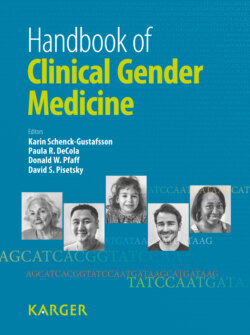Читать книгу Handbook of Clinical Gender Medicine - Группа авторов - Страница 18
На сайте Литреса книга снята с продажи.
The Morbidity and Mortality Paradox
ОглавлениеWhen we look at health status in terms of mortality rates, we see that men’s life expectancy at all ages is less than that of women in most countries around the world (on average around 6-8 years less). This mortality gap is wider in the former Soviet Union countries. In fact, Russia reached an unprecedented 13-year difference between male and female life expectancies in the 1990s; this is primarily attributed to high rates of circulatory disease among the men [9]. Meanwhile, in the USA and other high-income countries the gap is narrowing. The US 2010 census shows that the gender mortality gap is getting smaller, most significantly in the above 65 year range.
In general, the shorter life expectancy in men is thought to be the result of male behaviors including greater risk taking in relation to tobacco and alcohol use [1, 10]. It is also attributed to masculine attitudes towards health, such as not expressing pain or discomfort or acknowledging emotions [1, 10]. In some low-and middle-income countries in Asia, a deviation from this trend is seen; women’s life expectancy at birth is actually lower than or equal to men’s [11]. This is thought to be due to socially mediated causes including maternal mortality, disparities in access to care, female infanticide, and lack of female empowerment [11]. It is worth noting that, irrespective of the gender mortality trends, about 350,000 women die each year, predominantly in low-and middle-income countries, due to pregnancy and childbirth. Neither of these conditions in isolation constitutes an illness or disorder.
While men in most instances are more likely to die earlier than women, epidemiological information points to greater morbidity in women, based on rates of self-reporting and provider reporting [1, 12]. This finding is further supported by research in the USA that reveals that on a per capita basis women’s spending on health care services exceeds that of males [13]. Another study provides additional cultural insights in that women in Canada were shown to be more likely than men to report unmet health needs; this is within a country that provides universal basic care [14]. Women’s spending rates and their likelihood to report unmet health needs may be either a consequence of or a causative factor in the higher rates of morbidity in women.
Although the medical literature overwhelmingly points to a gender difference, there has been some questioning of the existence and the extent of any gender difference in morbidity. It has been proposed that when lifespan and disease area variation is accounted for, any noted difference in morbidity rates is attenuated [1]. Others reports suggest that the variation is an artifact due to factors such as higher rates of hospitalization due to childbirth in women, women’s increased tendency toward seeking out health services resulting in higher diagnosis rates as well as higher rates of medication usage, and women’s greater inclination to identify complaints believed to be health related [1].
